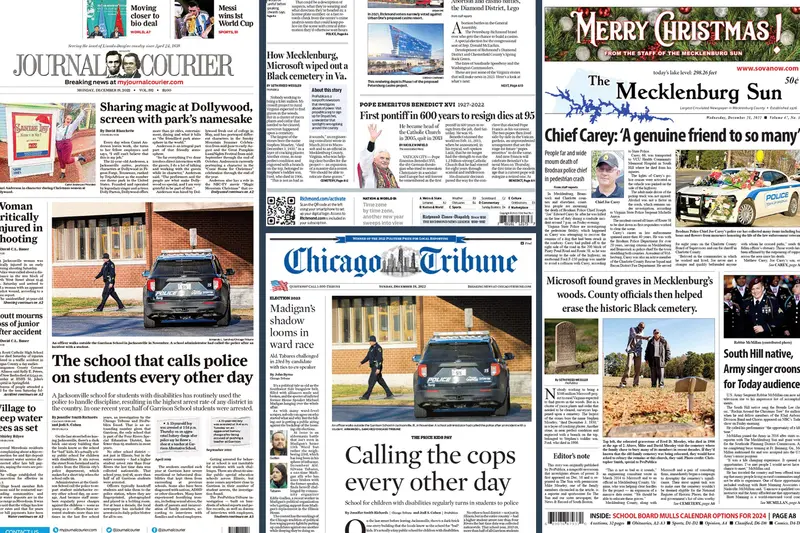The Ultimate Guide To News Articles
The Ultimate Guide To News Articles
Blog Article
Examine This Report on News Articles
Table of ContentsNot known Facts About News ArticlesAll about News ArticlesFascination About News ArticlesIndicators on News Articles You Need To KnowThe Best Strategy To Use For News Articles
Great expertise of different topics provides trainees an one-upmanship over their peers. Despite the fact that electronic and social media are readily accessible, we must not fail to remember just how vital it is to read the newspapers. Moms and dads should try and inculcate the habit of reviewing a paper as an everyday routine to continue the heritage of the revered print tool.Newspaper article additionally have at the very least among the complying with essential characteristics about the intended audience: closeness, importance, timeliness, human passion, curiosity, or effect. The associated term journalese is sometimes utilized, usually pejoratively, to refer to news-style writing. One more is headlinese. Papers usually abide by an expository writing style.
Within these restrictions, information stories likewise aim to be extensive. Among the larger and a lot more highly regarded newspapers, justness and balance is a significant variable in providing details.
Newspapers with an international audience, as an example, often tend to use an extra formal style of composing. The particular selections made by a news electrical outlet's editor or content board are often accumulated in a design guide; usual design guides include the and the US News Design Book. The main objectives of information writing can be summed up by the ABCs of journalism: precision, brevity, and clarity.
The News Articles Ideas
Generally, reporters will certainly not utilize a lengthy word when a short one will certainly do. They make use of subject-verb-object construction and vivid, active prose (see Grammar). They supply stories, examples and metaphors, and they rarely depend on generalizations or abstract ideas. Information writers attempt to stay clear of utilizing the exact same word greater than as soon as in a paragraph (often called an "echo" or "word mirror").
Headlines in some cases omit the topic (e.g., "Jumps From Watercraft, Catches in Wheel") or verb (e.g., "Cat woman lucky"). A subhead (also subhed, sub-headline, subheading, subtitle, deck or dek) can be either a secondary title under the major heading, or the heading of a subsection of the article. It is a heading that comes before the primary text, or a group of paragraphs of the main message.

of a post topic, source, or interviewee), it is described as a drawn quote or pull quote. Extra billboards of any of these kinds might show up later in the article (particularly on succeeding pages) to entice more reading. Journalistic web sites in some cases use computer animation strategies to exchange one billboard for one more (e.g.
Getting The News Articles To Work
Such signboards are additionally used as tips to the article in various other sections of the publication or site, or as ads for the item in other magazine or sites. News release of the Swiss government. Common framework with title, lead paragraph (recap in vibrant), other paragraphs (information) and contact information.

Example of a hard-lead paragraph NASA is suggesting one more space job. The spending plan requests around $10 billion for the task.
An "off-lead" is the second most important front web page information of the day. To "bury the lead" is to start the post with background details or details of second significance to the viewers, compeling them to read more deeply right into an article than they should have to in order to find the necessary points.
More About News Articles
Common usage is that a person or 2 sentences each develop their very own paragraph. Journalists typically describe the organization or structure of a news tale as an upside down pyramid. The crucial and most interesting aspects of a tale are placed at the beginning, with supporting info adhering to in order of lessening significance.
It permits individuals to discover a subject to just the deepness that their interest takes them, and without internet the charge of details or subtleties that they can think about pointless, however still visit the site making that information offered to much more interested visitors. The inverted pyramid structure additionally enables short articles to be trimmed to any type of approximate size during format, to suit the area offered.
Some writers start their tales with the "1-2-3 lead", yet there are several sort of lead offered. This layout inevitably begins with a "Five Ws" opening up paragraph (as explained over), followed by an indirect quote that serves to sustain a major element of the very first paragraph, and after that a straight quote to sustain the indirect quote. [] A kicker can describe numerous points: The last tale in the information program; a "happy" tale to end the show.
Longer articles, such as magazine cover posts and the pieces that lead the inside sections of a paper, are recognized as. Attribute stories differ from straight information in numerous ways. Foremost is the absence of a straight-news lead, many of the time. As opposed to using the essence of a tale in advance, attribute authors may attempt to draw visitors in.
News Articles - Questions
A function's very first paragraphs often associate an intriguing moment or event, as in an "unscientific lead". From the particulars of a person or episode, its view rapidly expands to generalizations regarding the tale's subject.

The Editor's Toolbox: A Recommendation Guide for Beginners and Professionals (2001) Allan M. Siegal click to read more and William G. Connolly. The New York City Times Guidebook of Design and Usage: The Authorities Design Overview Used by the Writers and Editors of the World's The majority of Authoritative Paper (2002) M. L. Stein, Susan Paterno, and R.
Report this page